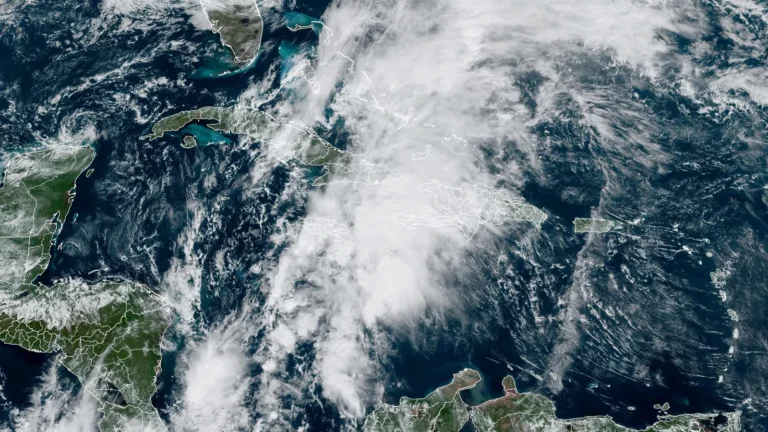
Potential Tropical Cyclone 22 will convey torrential downpours to the central and southwestern Caribbean on Friday afternoon, posing one of the harmful flooding threats of the 2023 Atlantic hurricane season. Of specific concern are the heavy rainfall occurring in southwestern Haiti, the place deforestation in mountainous areas places a extremely susceptible inhabitants prone to lethal flash floods.
As of 10 a.m. ET Friday, Potential Tropical Cyclone 22 (PTC 22) was situated roughly 155 miles west-southwest of Jamaica, transferring northeast at 14 mph with most sustained winds of 35 mph and central strain is 1004 MPa. Satellite tv for pc imagery exhibits that PTC 22 lacked a well-defined floor circulation however produced extreme storms that affected Costa Rica, Panama, Jamaica, jap Cuba, Haiti, the southeastern Bahamas, and the Turks and Caicos Islands.
PTC 22 Forecast
PTC 22 is experiencing sturdy wind shear and dry air intrusion, and the Nationwide Hurricane Middle advisory at 10 a.m. ET lowered the chance to a minimum of 40 % that it’s going to develop right into a tropical despair inside the subsequent 2 to 7 days. Growth is anticipated to be sluggish, with the very best likelihood for improvement showing to be Sunday, after the system strikes into the northern Caribbean. Nonetheless, whereas PTC 22 is anticipated to dump 4 to eight inches of rain alongside its path, with particular person quantities of as much as 16 inches, the potential for lethal flash flooding is excessive, particularly in southwestern Haiti.
The following identify on the Atlantic checklist this yr is Vince. If PTC 22 turns into Tropical Storm Vince, there will likely be just one identify left on the 2023 checklist: Whitney.
The loss of life toll within the 2023 Atlantic hurricane season is low to this point. Within the absence of official figures, three storms have prompted casualties to this point:
Hurricane Franklin: Two direct fatalities in Dominican Republic.
Hurricane Lee: Three direct deaths in U.S.
Hurricane Idalia: Seven direct deaths and three oblique deaths in the USA.
Quickly creating tropical storm situations severely impacting South Florida
From Tuesday night time into early Thursday, a lot of the densely populated hall from Fort Lauderdale to Miami and the Florida Keys was hit with 8 to 13 inches of rain and wind gusts in extra of fifty mph, with a collection of low to mild (average) storm intensified sharply with an extratropical storm south of Miami.
Rain gauges at Fort Lauderdale-Hollywood Worldwide Airport malfunctioned throughout Wednesday’s storm, simply as they did throughout an epic flood in April. Regardless of the most recent knowledge breach, the airport has formally gathered 101.00 inches of rain as of Thursday night time, 2023, rapidly approaching Fort Lauderdale’s all-time report of 102.36 inches set in 1947.
Most 48-hour rainfall totals by way of the morning of Thursday, November 16, embody the next, compiled from numerous official and unofficial sources (see the complete checklist posted by the Nationwide Climate Service’s Miami and Key West places of work):
Monroe County: Lagos, 13.80 inches Broward County: Lauderdale-by-the-Sea, 13.31 inches Miami-Dade County: Biscayne Park, 10.12 inches Palm Seaside County: Delray Seaside, 6.19 inches Collier County : Orange Terry, 5.17 inches
Peak gusts, together with offshore and inland websites, embody the next, additionally compiled from the Miami and Key West places of work. Sustained speeds at airports are derived from hourly stories, so greater values could exist in these stories.
Carlisford Ocean Mild: 87 mph Authorities Shear (south finish of Miami Seaside): 75 mph Port Everglades: 73 mph (67 mph sustained) Dania Marina: 70 mph Virginia Keys: 57 mph (steady 40 mph) Lengthy Key: 56 mph Airport Fort Lauderdale-Hollywood Worldwide Airport: 55 mph (steady 32 mph) Homestead Air Pressure Reserve Base: 55 mph (steady 33 mph) Palm Seaside Worldwide Airport: 56 mph (steady 38 mph)
Extreme climate and floor low strain developed east of an upper-level, non-tropical low transferring throughout the Gulf of Mexico. If this shallow low, linked to an upper-level low, has a coherent and protracted construction, it may be designated a subtropical despair. On this case, the radar picture exhibits a collection of (low-to-medium) strata, comparable to those who could develop in a Midwestern storm complicated, somewhat than a persistent shallow heart. Apparently, Florida State College’s part house classification software (Determine 2), which is predicated on GFS mannequin steerage, strongly means that the complicated can have symmetrical heat core traits (i.e., traits related to tropical storms and hurricanes).


The quickly creating storm complicated over southern Florida is just not designated as a tropical or subtropical cyclone by the Nationwide Hurricane Middle. Generally the middle will “replace” nontropical techniques in future analyses. This occurred on January 16-17 with a system within the northwest Atlantic that was later confirmed as a subtropical storm, which means that if it had been tracked as a subtropical storm from the start, it might have turn out to be the 2023 The primary named storm of the yr. Given the non-tropical nature of the South Florida system this week, the probability of such an replace appears slim, however we’ll see if the middle decides to do a postmortem.